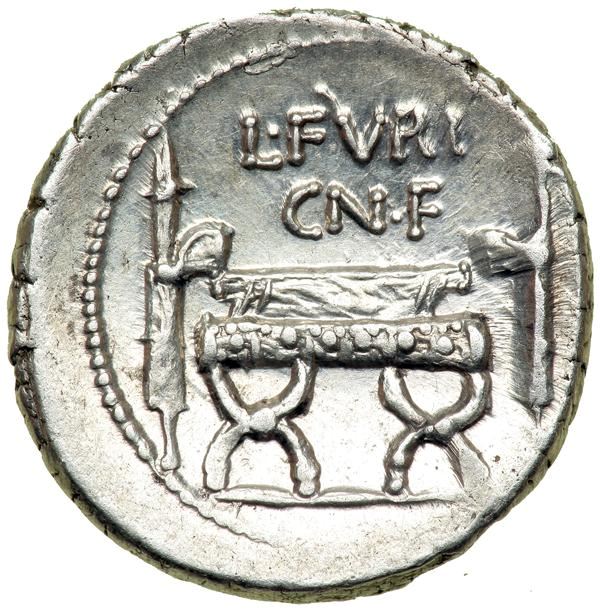L. Furius Brocchus was one of the moneyers for the year 63 BC.
He is not otherwise known. Babelon has suggested that the head of Ceres refers to the grain distributions conducted by the plebeian aediles.
The curule chair and fasces, however, indicate the curule, not the plebeian, aedileship. The head of Ceres and the grain symbols may refer to the largess that Brocchus would have provided to the public had he served as plebeian aedile. The curule chair and fasces probably refer to his actual service as curule aedile.
He is not otherwise known. Babelon has suggested that the head of Ceres refers to the grain distributions conducted by the plebeian aediles.
The curule chair and fasces, however, indicate the curule, not the plebeian, aedileship. The head of Ceres and the grain symbols may refer to the largess that Brocchus would have provided to the public had he served as plebeian aedile. The curule chair and fasces probably refer to his actual service as curule aedile.


Obverse: Bust of Ceres right, between wheat-ear and barley corn; III-VIR across fields, BROCCHI below.
Reverse: Curule chair between fasces, L•FVRI CN•F above.
Diameter:
19 mm
Die Orientation: 6 H
Weight: 3.95 g
Die Orientation: 6 H
Weight: 3.95 g
"The obverse possibly relates to a family history where an ancestor served as aedile of the grain supply, the cura annonae, or it may just reflect the moneyer's populist political philosophy. At the time this coin was struck, Catiline's conspiracy was secretly developing, only to be exposed and crushed the following year during Cicero's consulship. Although grain shortage was not one of the social causes of the Catiline conspiracy as outlined by Cicero - remember that Pompey had cleared the Mediterranean of the pirate menace in the early 60s BC and thus the grain supply had been secured - after the revelation of the plot, Cato proposed a grain measure extending the dole to include Rome's poor. Obviously, then, even though supply was plentiful, it was a source of discontent for the many urban plebs who were not benefitting from free distribution, and perhaps it was this mood that Brocchus was attempting to exploit by his choice of types on this coin."
"Ceres was the Roman goddess of agriculture. She was equivalent to the Greek Demeter. The curule chair (sella curulis) was the official chair of the 'curule' magistracies: the consulship, the praetorship, and the 'curule' aedileship (the two highest aediles). The fasces were bundles of rods bound together. The rods symbolized the power to inflict physical punishment. When an axe (securis) was bound in the middle of the rods, it signified the power to inflict death."
Provenance: CNG 106 (13 September 2017), lot 659.
"Ceres was the Roman goddess of agriculture. She was equivalent to the Greek Demeter. The curule chair (sella curulis) was the official chair of the 'curule' magistracies: the consulship, the praetorship, and the 'curule' aedileship (the two highest aediles). The fasces were bundles of rods bound together. The rods symbolized the power to inflict physical punishment. When an axe (securis) was bound in the middle of the rods, it signified the power to inflict death."
Provenance: CNG 106 (13 September 2017), lot 659.
Crawford 414/1
